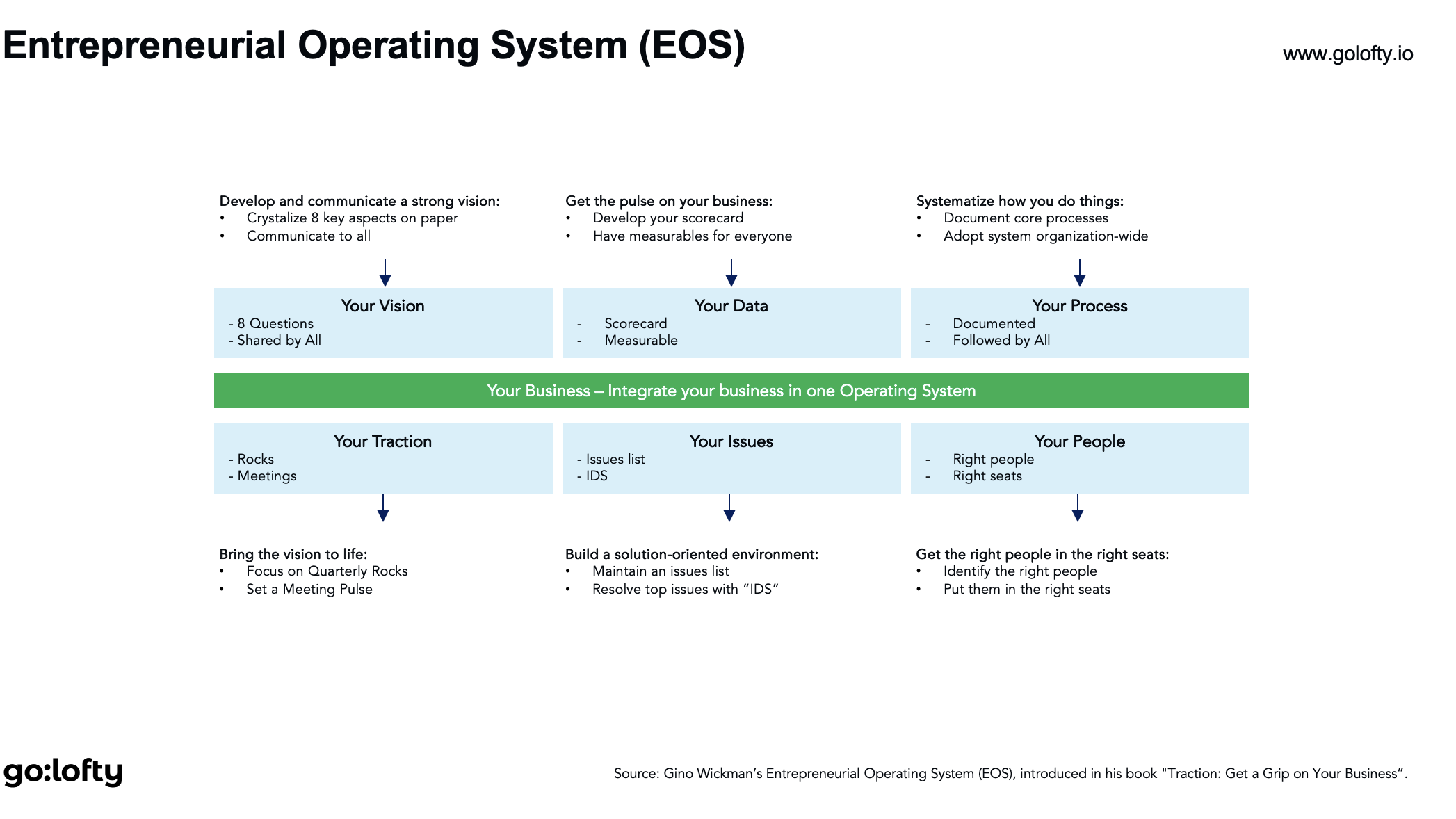
Mastering Business with EOS: Lessons from “Traction” by Gino Wickman
In today’s fast-paced business world, countless entrepreneurs and business leaders struggle with a common challenge: bridging the gap between strategy and execution. It’s one thing to have a brilliant vision for your company’s future, but quite another to consistently execute that vision across every level of your organization. This is where Gino Wickman’s Entrepreneurial Operating System (EOS), introduced in his book “Traction: Get a Grip on Your Business”, becomes a game-changer.
EOS provides a practical, actionable framework designed to help companies of all sizes align their teams, improve efficiency, and stay laser-focused on achieving their business objectives. If you’ve ever felt overwhelmed by the complexities of running a business—too many moving parts, lack of focus, or disjointed teams—EOS might just be the solution you need.
What Is EOS and Why Does It Matter?
EOS, or the Entrepreneurial Operating System, is a comprehensive system designed to simplify the chaos of running a business. At its core, EOS focuses on six key components that every business needs to manage and strengthen to grow successfully:
- Vision: Clarifying where your organization is going and how it plans to get there.
- People: Ensuring you have the right people in the right roles.
- Data: Focusing on key metrics to measure performance objectively.
- Issues: Identifying and solving problems quickly and effectively.
- Processes: Streamlining the way work is done to increase efficiency.
- Traction: Bringing the vision to life through disciplined execution.
Unlike some high-level business frameworks that get bogged down in theory, EOS is intensely practical. It’s designed to help leaders get their organizations unstuck, build discipline into their processes, and empower teams to take ownership of their goals. In short, EOS isn’t just about planning—it’s about taking consistent action.
The Power of Vision: Starting with Clarity
The first step in the EOS process is to define a crystal-clear vision. Wickman emphasizes the importance of every member of the organization being aligned with this vision. But clarity doesn’t stop at the top of the organization—it needs to cascade through every level, from senior leadership down to frontline employees.
Wickman introduces the Vision/Traction Organizer (V/TO) as a tool to help leaders define and communicate their company’s vision. This involves answering key questions like:
- What is your core purpose?
- What are your core values?
- What is your long-term goal (10-year target)?
- What are your 3-year and 1-year goals?
By clearly articulating the vision, companies ensure that everyone understands where they’re going and why, creating alignment and purpose across the organization.
People: The Right Roles, the Right Seats
Wickman’s mantra in the people component of EOS is simple but powerful: “Right people, right seats.” For an organization to succeed, it’s not enough to hire talented individuals—you need people who align with the company’s values and goals, and who are in roles where they can thrive.
EOS uses a tool called the People Analyzer, which helps leaders evaluate their team based on core values and job performance. The goal is to make sure every employee is a good fit for both the company’s culture and their specific role.
In this process, tough decisions are sometimes required. Wickman advocates for ensuring that each team member contributes to the company’s growth and success. When people are placed in roles that align with their strengths and the company’s objectives, the organization runs more smoothly, and employees are more engaged.
Data: Running Your Business by the Numbers
In many businesses, decision-making is often driven by gut feelings or vague assessments of progress. Wickman’s EOS encourages leaders to run their businesses on data. By identifying and tracking a small set of key metrics, businesses can objectively measure their performance and make data-driven decisions.
The Scorecard is one of the tools introduced in EOS. It helps businesses track weekly metrics—whether it’s sales leads, customer satisfaction, or financial performance—that offer a clear snapshot of how the company is doing. With these numbers in hand, leaders can identify issues early and course-correct before problems escalate.
Issues: Facing Problems Head-On
Every organization faces challenges, but how those challenges are managed can make or break a business. EOS emphasizes the need to identify, discuss, and solve problems quickly and effectively. Wickman advocates for creating a culture where issues aren’t avoided or swept under the rug but are brought to the surface, discussed openly, and addressed head-on.
One of the tools in EOS for addressing problems is the IDS (Identify, Discuss, Solve) method. Teams work together to identify the root cause of an issue, discuss possible solutions, and then implement those solutions with a clear plan of action. This process ensures that problems are addressed efficiently, preventing them from derailing the company’s progress.
Processes: Streamlining for Efficiency
A company is only as efficient as its processes allow it to be. EOS encourages businesses to document and simplify their core processes so that work gets done consistently and efficiently across the organization. Whether it’s how a product is manufactured, how sales are made, or how customer service is handled, EOS emphasizes the importance of clear, streamlined processes that eliminate waste and confusion.
The key here is not to overcomplicate things. Wickman advises companies to document only the core processes that drive value and ensure that they’re simple enough for everyone in the organization to follow. By getting processes right, companies can scale more easily and maintain high performance as they grow.
Traction: Turning Vision into Reality
The final piece of the EOS puzzle is traction—the discipline and accountability needed to bring the vision to life. This is where strategy meets execution. In the EOS model, traction is achieved through regular meetings, clear priorities, and a focus on accountability.
Wickman introduces Rocks, which are the 90-day priorities that help teams focus on what’s most important right now. Instead of being overwhelmed by long-term goals, teams break down those goals into manageable chunks, working on three to seven key Rocks each quarter.
In addition, Wickman stresses the importance of weekly meetings to review progress, address issues, and stay on track. These meetings ensure that the team remains focused and aligned with the company’s objectives, building momentum over time.
Why EOS Matters for Entrepreneurs and Business Leaders
The beauty of EOS lies in its simplicity and applicability. Whether you’re leading a startup or managing a more established business, EOS offers a straightforward, actionable framework for success. It’s not about radical new theories or complex models—it’s about getting the basics right: a clear vision, the right people, good data, and disciplined execution.
For business leaders struggling to bridge the gap between strategy and execution, EOS provides the tools to gain traction, improve focus, and create a culture of accountability. By implementing EOS, companies can stop spinning their wheels and start moving toward their long-term goals with purpose and clarity.
At Go:lofty Consulting, we help businesses adopt the EOS framework, aligning strategy with execution to drive sustainable growth. Contact us to learn how EOS can transform your business and empower your teams to execute with precision and accountability.




